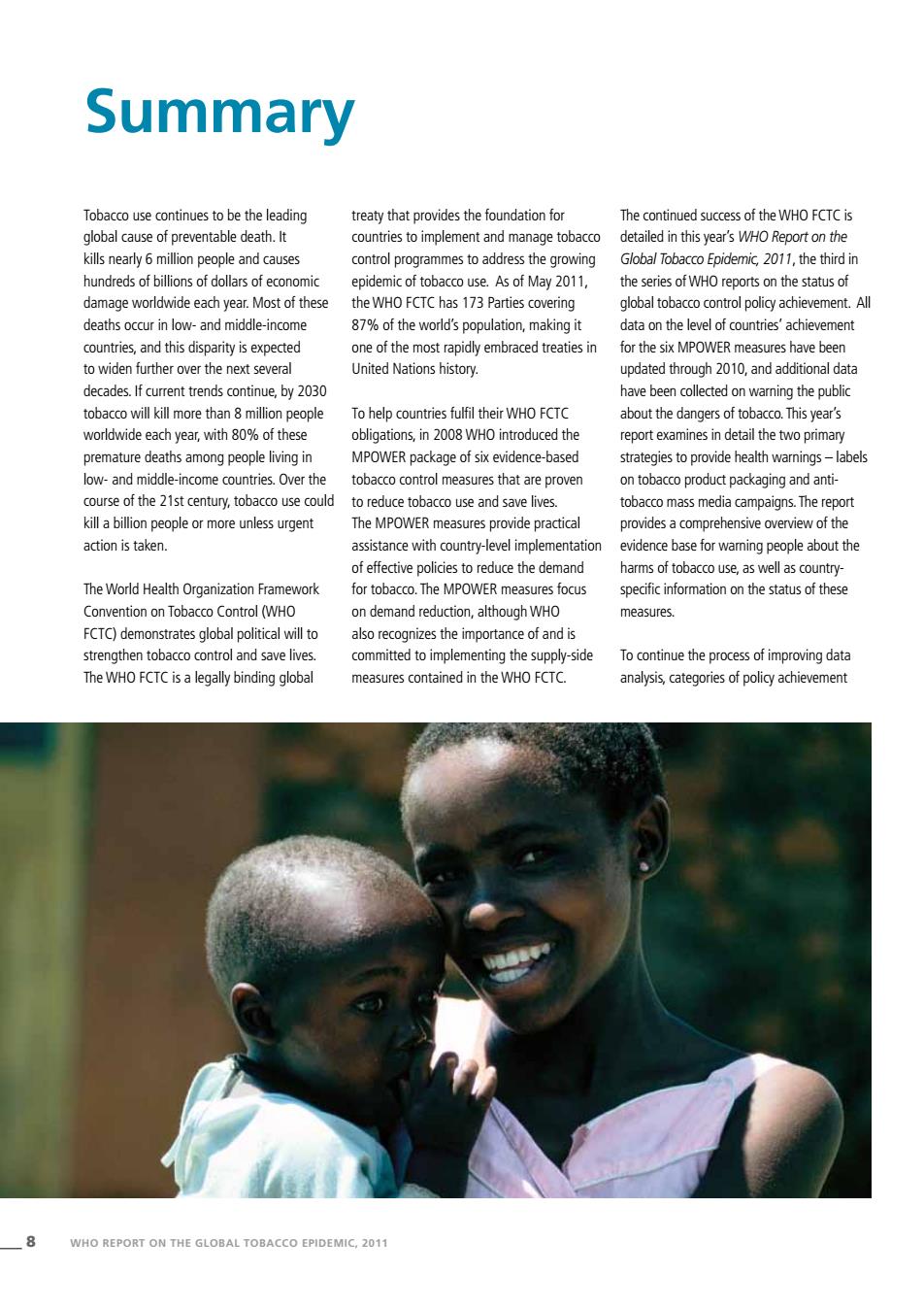正在加载图片...

Summary Tobacco use continues to be the leading treaty that provides the foundation for The continued success of the WHO FCTC is global cause of preventable death.It countries to implement and manage tobacco detailed in this year's WHO Report on the kills nearly 6 million people and causes control programmes to address the growing Global Tobacco Epidemic,2011,the third in hundreds of billions of dollars of economic epidemic of tobacco use.As of May 2011, the series of WHO reports on the status of damage worldwide each year.Most of these the WHO FCTC has 173 Parties covering global tobacco control policy achievement.All deaths occur in low-and middle-income 87%of the world's population,making it data on the level of countries'achievement countries,and this disparity is expected one of the most rapidly embraced treaties in for the six MPOWER measures have been to widen further over the next several United Nations history. updated through 2010,and additional data decades.If current trends continue,by 2030 have been collected on warning the public tobacco will kill more than 8 million people To help countries fulfil their WHO FCTC about the dangers of tobacco.This year's worldwide each year,with 80%of these obligations,in 2008 WHO introduced the report examines in detail the two primary premature deaths among people living in MPOWER package of six evidence-based strategies to provide health warnings-labels low-and middle-income countries.Over the tobacco control measures that are proven on tobacco product packaging and anti- course of the 21st century,tobacco use could to reduce tobacco use and save lives. tobacco mass media campaigns.The report kill a billion people or more unless urgent The MPOWER measures provide practical provides a comprehensive overview of the action is taken. assistance with country-level implementation evidence base for waming people about the of effective policies to reduce the demand harms of tobacco use,as well as country- The World Health Organization Framework for tobacco.The MPOWER measures focus specific information on the status of these Convention on Tobacco Control (WHO on demand reduction,although WHO measures. FCTC)demonstrates global political will to also recognizes the importance of and is strengthen tobacco control and save lives. committed to implementing the supply-side To continue the process of improving data The WHO FCTC is a legally binding global measures contained in the WHO FCTC. analysis,categories of policy achievement 8 WHO REPORT ON THE GLOBAL TOBACCO EPIDEMIC,20118 WHO REPORT ON THE GLOBAL TOBACCO EPIDEMIC, 2011 Tobacco use continues to be the leading global cause of preventable death. It kills nearly 6 million people and causes hundreds of billions of dollars of economic damage worldwide each year. Most of these deaths occur in low- and middle-income countries, and this disparity is expected to widen further over the next several decades. If current trends continue, by 2030 tobacco will kill more than 8 million people worldwide each year, with 80% of these premature deaths among people living in low- and middle-income countries. Over the course of the 21st century, tobacco use could kill a billion people or more unless urgent action is taken. The World Health Organization Framework Convention on Tobacco Control (WHO FCTC) demonstrates global political will to strengthen tobacco control and save lives. The WHO FCTC is a legally binding global Summary treaty that provides the foundation for countries to implement and manage tobacco control programmes to address the growing epidemic of tobacco use. As of May 2011, the WHO FCTC has 173 Parties covering 87% of the world’s population, making it one of the most rapidly embraced treaties in United Nations history. To help countries fulfil their WHO FCTC obligations, in 2008 WHO introduced the MPOWER package of six evidence-based tobacco control measures that are proven to reduce tobacco use and save lives. The MPOWER measures provide practical assistance with country-level implementation of effective policies to reduce the demand for tobacco. The MPOWER measures focus on demand reduction, although WHO also recognizes the importance of and is committed to implementing the supply-side measures contained in the WHO FCTC. The continued success of the WHO FCTC is detailed in this year’s WHO Report on the Global Tobacco Epidemic, 2011, the third in the series of WHO reports on the status of global tobacco control policy achievement. All data on the level of countries’ achievement for the six MPOWER measures have been updated through 2010, and additional data have been collected on warning the public about the dangers of tobacco. This year’s report examines in detail the two primary strategies to provide health warnings – labels on tobacco product packaging and antitobacco mass media campaigns. The report provides a comprehensive overview of the evidence base for warning people about the harms of tobacco use, as well as countryspecific information on the status of these measures. To continue the process of improving data analysis, categories of policy achievement